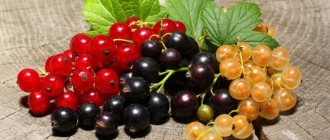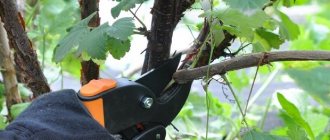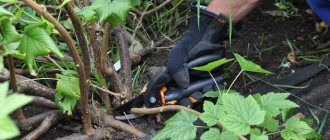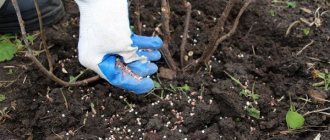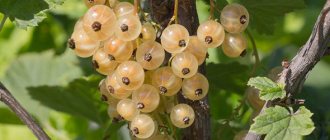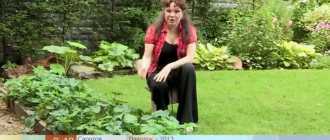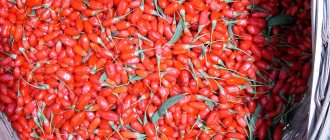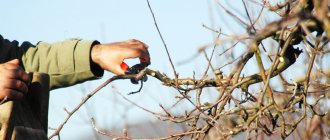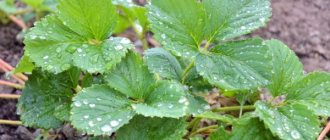Why prune currants in summer?
Black, white and red currants are representatives of the Gooseberry family. Perennial shrubs are popular due to their ease of care and the sweet and sour taste of the berries. Most often black currants are grown in Russia, less often red and white.
The plants have a compact or spreading crown, depending on the variety, the height reaches 1.5 m. The bushes actively develop up to 2 years, then the set of green mass stops, and the plants enter the fruiting phase. The first harvest is harvested 2 years after planting, but maximum productivity of currants is observed at the age of 5-6 years.
Currants bear fruit every day; on average, 3–7 kg of berries are collected from a bush . Red and white varieties ripen at the end of June, black - in mid-July. It is after the harvest that they begin to prune the bushes, although disputes about carrying out this procedure in the summer do not fade away.
Many gardeners are sure that summer pruning improves the illumination and aeration of the central shoots, so the lateral young shoots develop better. Adherents of a different opinion do not recommend trimming weak shrubs in the summer, since the procedure inhibits the growth of shoots and enhances the generative development of the plant.
Pruning goals
Summer pruning is aimed at changing the direction of shoot growth. Thanks to this, the bushes look attractive and neat, the berries ripen large and sweet.
Gardeners themselves decide whether to prune in the summer or postpone until the fall. However, the currants survive the procedure without loss. Thanks to proper formation, it is possible to avoid fungal diseases and achieve maximum productivity.
If you ignore pruning, the bushes thicken over time, and dry dead branches block access to light and air. This causes the berries to become smaller, the flower stalks and ovaries become smaller, and the bushes age prematurely.
Formative and rejuvenating pruning of currants is carried out in spring and autumn. At the same time, dry, diseased, damaged and fruit-bearing branches are removed, and the growth of future young shoots is set. Autumn pruning is carried out after the bushes have shed their leaves.
It is important to allow assimilates from old branches to flow into the root system. In winter, the plant will receive vital substances from reserves.
How to treat currants after pruning?
Prudent owners of berry plantations limit the application of pesticides during the harvest period. For almost a month in the summer, the bushes stand without protection; as an exception, spraying is carried out with biological products with the shortest waiting period. After pruning, currants need immediate inspection for the appearance of pests and diseases and subsequent spraying with an effective preparation. It is better to close large wounds on old growth with garden varnish. If the berries are collected, then use the following products to treat the crown against infections and parasites:
- Bitoxibacillin (bioinsecticide);
- Fitoverm (biological insectoacaricide);
- Fufanon (insectoacaricide);
- Skor (fungicide).
Timing for pruning
Experienced gardeners recommend performing exclusively sanitary pruning of currants after harvesting. The exact timing of the procedure is not provided; it is better to focus on the climatic characteristics of the growing region.
Reference. The procedure is performed in dry weather. Dry and sun-warmed shoots are easier to prune.
The approximate timing of pruning after fruiting is from July to September. In the south, the procedure is performed from mid-June to early July, in the northern and central regions - from August.
Favorable days
Adherents of gardening according to the phases of the moon advise adhering to the lunar calendar.
Favorable days for pruning currants in 2020:
- June: 1–6, 8, 12, 13, 17–19, 22, 23, 26–28, 30;
- July: 1–3, 7–12, 14–18, 22–31;
- August: 1, 2, 6, 7, 10–16, 20–26, 28, 29;
- September: 1–3, 6–13, 18–24, 29, 30.
Favorable days for pruning in 2021:
- June: 2, 3, 6–8, 11–13, 16, 19–25, 29, 30;
- July: 4–8, 13–17, 19–23, 27, 28, 31;
- August: 1–6, 10–15, 17–19, 23, 27–31;
- September: 1–3, 8–13, 15, 16, 19, 20, 24–30.
Time of procedure after harvest
Various types of such treatment are carried out at different times of the year: spring, summer and autumn. The exact time depends on the climate and the stage of vegetative development of the plant. For example, in summer this procedure should be carried out immediately after harvesting. Don't wait until the plant begins to prepare for winter.
Having collected the last berries, you should immediately pick up a pruner to remove excess branches. First of all, you need to pay attention to the shoots that shade the remaining parts of the currant. You shouldn’t get too carried away, since the reaction to pruning will be the appearance of new stems, and the bush should spend energy only on thickening the bark for winter.
If you focus on months, then it is necessary to harvest the crop and remove excess branches before the beginning of August. But the timing should be adjusted according to weather conditions.
How to prune currants correctly
When pruning currants in summer, it is important to use a sharp, disinfected tool and follow the sequence of removing branches.
Required materials and tools
Equipment for pruning bushes is pre-disinfected to prevent fungal infections.
Used for gardening work:
- garden scissors (secateurs) for removing young growth;
- lopper for cutting thick branches;
- knife for correcting uneven areas;
- rake for collecting shoots and leaves;
- medical alcohol, vodka, kerosene, 3% solution of copper sulfate or potassium permanganate for disinfecting equipment.
Step-by-step pruning instructions
Currant pruning technology:
- Remove all diseased, old, moss-covered, dry and damaged branches, as well as those that are 4-5 years old.
- Branches that are strongly inclined and lying on the ground are pruned, since in summer they lack sunlight and do not bear fruit.
- Zero young replacement shoots are shortened by 1/3 above the buds for better branching.
- Renew 2-3-year-old branches: remove one-year growth, weak side shoots with a small number of buds to stimulate the growth of the remaining branches.
- The tops of young growth on 2-3 year old branches above the buds are trimmed for better branching.
- Second-order branches longer than 40–50 cm are shortened.
- Remove young growth directed to the center of the bush to prevent thickening.
A black hole in the center of a cut branch indicates a glassworm infestation. Such a shoot is completely removed.
Summer pruning and feeding of black currants.
Pruning currants in spring
Pruning currants in spring has the following advantages:
- Weak and broken branches will not draw nutrients after winter, when the plant needs to recover and begin to bloom. Strength will be spent on producing new, healthy and fruit-bearing shoots.
- Old ones that did not have berries are eliminated.
- The middle ones are cut off, which can shade and prevent the berries from receiving enough sunlight. As a result of thinning, future berries acquire bright color and taste.
- A bush freed from excess “load” can provide more nutrients to its fruits.
- Spring pruning prevents the development of diseases and the activation of pests under the bark. They can move from diseased and old branches to healthy ones and infect the entire plant.
But it is important to take into account some of the disadvantages of spring pruning:
- They should be carried out within a certain period. Otherwise, the wounds will take too long to heal. The plant will spend a lot of energy on restoration, and not on berries.
- Poor processing of the cut will expose the bush to the risk of pests and diseases.
Carry out pruning in the spring according to the following rules:
- Trim the bush when the weather becomes consistently warm - above +5 degrees, and the danger of repeated frosts has passed. A sign of this is the uniform melting of snow throughout the entire area.
- Do not leave shoots that grow towards the center of the bush.
- Remove young and empty shoots, as they only draw nutrients, but do not bear fruit.
- In order for the bush to grow wider, the last 2 buds on each shoot are cut off.
- The cut is made at an angle of 45 degrees above the bud, pointing outward.
- Do not leave stumps from old branches, as insects and fungi settle in them.
Remember that all manipulations are carried out with clean equipment, treated in a weak solution of potassium permanganate, otherwise you will cause an infection.
To minimize the loss of juice and disinfect against diseases and fungi, treat all cuts with garden varnish. You can purchase it at any gardening or flower shop.
Features of pruning black, red and white currants
The red and white varieties have almost the same bush structure and type of fruiting. In these plants, 7-8 year old branches are considered old, and the peak of fruiting occurs at 5 years. It is recommended to start formative pruning of bushes at the end of July, after harvesting.
Pruning red currants involves:
- removal of all internal young shoots shading fruiting branches;
- pruning old fruit-bearing branches above the level of the strongest side shoot;
- cutting out zero shoots emerging directly from the soil around the bush (they can be dug in to get layering);
- removal of damaged, dry and diseased shoots.
A properly formed red currant bush should have up to 25 branches 1–8 years old.
The principle of pruning black currants is slightly different. This is due to the fact that more berries ripen on two-year-old shoots. Therefore, it is important to completely remove old branches (over 5 years old) and pinch out annual stems. Some gardeners recommend combining formative and sanitary pruning.
Reference. Late varieties of black currant bear fruit in August, so the summer procedure is postponed to September - October.
It is forbidden to shorten the tops of black currants too much: this leads to the loss of most of the harvest. This procedure is carried out with red and white varieties.
Nuances for bushes of different ages
Currants are difficult to tolerate pruning; it is very stressful for them. If during the procedure there are breaks and other damage on the shoots, the plant will direct all its efforts to heal them. Therefore, it is extremely important to use a sharply sharpened tool in your work.
The principle of pruning currants also depends on its age:
- After planting the seedling, remove all branches above 4 buds from the base of the soil. Next year, at least 4–8 shoots from the remaining buds will appear on the bush.
- After 1 year, pinch the tops of all young shoots 1/3 above the buds.
- After 2 years, pinch out all zero shoots and parts of skeletal branches. On two-year-old branches, one-year growth and strong lateral branches are removed, leaving only strong shoots with a large number of buds to enhance the growth of the remaining branches. To stimulate branching, cut off all the tops of the remaining growth of the first and second order above the buds.
- After 3 years, all thickening shoots are cut off.
- In the 4th year and beyond, senescent shoots are formed. At the end of the season, all old branches are cut off at the root, the remaining four-year-old shoots are shortened according to the principle of a three-year-old seedling. Each year, 3–6 zero replacement shoots are left.
Why is pruning done?
Correct and timely pruning of currant bushes serves several purposes.
The procedure is necessary because it gives the following results:
- increasing the amount of nutrients supplied to the buds and shoots that will bear fruit next year;
- reducing the risk of fungal, bacterial and viral diseases;
- reducing the risk of pest infestation;
- ensuring a beautiful and correct shape of the bush, which not only looks attractive, but also provides convenience when picking berries;
- getting rid of old and weak shoots, which only take away the plant’s strength and worsen the condition before wintering;
- rejuvenation of the bush, which helps to extend its fruiting period.
The reasons for pruning are the same for all varieties of currants. If you neglect this procedure, the bushes will be weak and the yield will be significantly lower.
Post-procedure care
Currants love moisture and respond to sufficient watering with a good harvest . During the period of fruit formation, the crop feels its maximum need for liquid. Excessively dry soil causes the berries to shrink and fall off. Water is poured under the root in dry weather once every 10 days, spending 50–60 liters per bush. Spraying on leaves is not practiced as it leads to the development of powdery mildew.
After each watering, the soil in the tree trunk circle is loosened to improve aeration of the root system . They do this extremely carefully: currants have a superficial root system, the suction roots are barely covered with soil. To reduce the frequency of loosening, the area is covered with a 6–8 cm layer of mulch (straw, hay, peat). Mulch inhibits the growth of weeds and retains moisture in the soil. As plant residues decay, nutrients penetrate into the soil along with water.
After summer pruning, currants are fed with phosphorus and potassium fertilizers (70–100 g of phosphorus, 30–50 g of potassium or 100–300 g of complex fertilizers per 1 m²). Compost and humus are applied once every 3 years, 10 kg per bush. Of particular benefit is fertilizing with a urea solution (3 matchboxes per 10 liters of water per 1 bush). Plants older than 4 years are fertilized with urea in smaller quantities: 25–30 g per bush. Fertilize in 2 doses with an interval of 14 days.
How to feed currants after fruiting and pruning?
After pruning the currants in the summer after collecting all the berries has been completed successfully, you can improve its condition by applying fertilizers. This procedure helps restore the shrub’s strength at the time of laying fruit-bearing buds. There are many options that can be applied in the form of fertilizing for berry crops:
- Adding compost (up to a couple of buckets under the plant).
- Admirers of organics replenish it by watering the currants after picking the berries with infusions based on droppings or mullein.
- Feeding plants with a solution of superphosphate and potassium sulfate - you need to stir a tablespoon of each component into a bucket of heated water.
- Application of ready-made preparations with a complex composition (Kemira, Zelenyi Gai, Master, Plantator, BioMaster) after the completion of berry picking. When choosing a store-bought product for this purpose in the summer, we give preference to water-soluble fertilizers with a high content of potassium-phosphorus components.
How to fertilize currants after pruning in summer:
- It is advisable to rake the old layer of mulch in the tree trunk circle to the side.
- Lightly loosen the soil around the bushes.
- We do this procedure in the summer after picking berries with caution so that the roots are not damaged.
- We burn the dried mulch, guaranteeing the destruction of pests hiding among the straw and leaves.
- We create a hole near the bush.
- We water the currants by pouring up to 5 buckets under an adult plant.
- We add compost or prepared liquid fertilizer to the watered berry crop.
- We lay new mulch under the currants.
Advice from experienced gardeners
When growing currants, beginners encounter some difficulties, which the advice of experienced gardeners will help them cope with:
- Removing a large number of shoots is the most common mistake when pruning currants in summer. Remember that old, diseased, damaged shoots lying on the ground and annual thickening growth must be removed.
- In July and August, active sap flow begins, so after removing thick branches, treat the cuts with garden varnish.
- When pruning red and white currants, do not remove 2-3-year-old shoots: they branch well without additional pruning.
- Leave 9-12 shoots on each bush at 1-3 years of age to increase yield.
- In mid-July, feed the currant bushes with organic matter: 1 liter of mullein per 10 liters of water or 0.5 liters of bird droppings infusion per 10 liters of water. Consumption for 1 bush - 2-3 buckets.
- In order not to carry water for irrigation in buckets to the site, especially if the plantation is large, take a hose, lower it into the bucket and note how long it takes for it to become full. Multiply this time by the required number of buckets. For example, if the container is filled in 1 minute, 1 bush requires 5 buckets - accordingly, keep the hose under the plant for 5 minutes. To better absorb water into the soil, keep the pressure low.
Trimming procedure
Red and black currants should be pruned following some basic rules used by experienced gardeners. They prefer to act in stages. First you need to carry out sanitary pruning.
It includes the following actions:
- freeing the bush from diseased, rotten, dried and broken branches;
- cut off shoots that do not ripen in summer;
- remove branches lying on the ground and intertwined in the middle of the bush.
Then you can begin the next stage - rejuvenating. To do this, you need to get rid of those branches that are more than 5-7 years old. Shoots that appeared this year should be shortened by a third.
Then it is necessary to carry out maintenance pruning. It should be carried out at a time when the bush looks unkempt. You need to cut branches from the middle so that the sun's rays penetrate inside the bush. But you cannot get too carried away with this process, otherwise the culture will experience severe stress.
Many gardeners use radical methods of pruning blackcurrants. This procedure is performed if the yield drops sharply. It can be done both in spring and autumn. It consists of completely cutting off the currants at a height of 3 cm from the ground. It is important to feed the soil. This method will allow new, viable shoots to grow in the spring.
A good method of pruning currants in the fall is recommended for beginner gardeners who do not yet have experience and certain skills. In this case, beginners will not need to understand the age of the shoots. All branches that have grown less than 15 cm during the summer should be cut off.
Many gardeners recommend following the lunar calendar when choosing pruning dates. However, in any case, you will need to wait until the end of fruiting.
